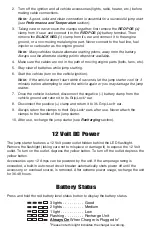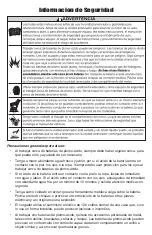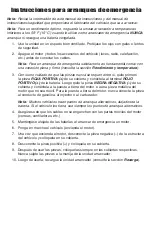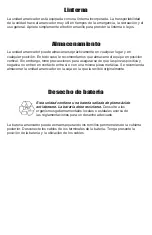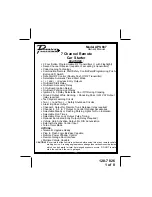
General precautions for use:
• Someone should always be within range of your voice or close enough to come to
your aid when you work near a lead-acid battery.
• Have plenty of fresh water and soap nearby in case battery acid contacts skin,
clothing or eyes. Protective eyewear should always be worn when working near
lead-acid batteries.
• If battery acid contacts skin or clothing, wash immediately with soap and water.
If acid enters eye, immediately flood eye with cold running water for at least 10
minutes and get medical attention immediately.
• The charger uses household 120V electrical supply, which if misused, may cause
injury or fire.
• Be extra cautious to reduce risk of dropping a metal tool onto a battery. It might
spark or short circuit the battery or another electrical part that may cause explosion.
• Remove personal metal items such as rings, bracelets, necklaces and watches when
working with a lead-acid battery. A lead-acid battery can produce a short-circuit
current high enough to weld a ring or the like to metal, causing a severe burn.
• Use the jump starter for jump starting lead-acid batteries only. Do not use for jump
starting dry-cell batteries that are commonly used with home appliances. These
batteries may burst and cause injury to persons and damage to property.
• NEVER charge or jump start a frozen battery.
Failure to follow instructions may cause damage or explosion; always shield eyes.
Read entire instruction manual before use.
WARNING
Never turn the
Car Start ON if the LED light is RED and the unit emits an audible alarm.
Doing so could cause sparking, explosion or other damage to your vehicle's electrical
system and the
Car Start, as well as personal injury.
Never turn the
Car Start ON before connecting the Car Start to a vehicle/battery.
WARNING
WARNING
Read these instructions completely before using the jump starter and save them for
future reference. Before using the jump starter to jump start a car, truck, boat or to
power any equipment, read these instructions and the instruction manual/safety
information provided by the car, truck, boat or equipment manufacturer. Following all
manufacturers’ instructions and safety procedures will reduce the risk of accident.
Working around lead-acid batteries may be dangerous. Lead-acid batteries release
explosive gases during normal operation, charging and jump starting. Carefully read and
follow these instructions for safe use. Always follow the specific instructions in this
manual and on the jump starter each time you jump start using the jump starter.
All lead-acid batteries (car, truck and boat) produce hydrogen gas which may violently
explode in the presence of fire or sparks.
Do not smoke, use matches or a cigarette
lighter while near batteries. Do not handle the battery while wearing vinyl clothing
because static electricity sparks are generated when vinyl clothing is rubbed. Review all
cautionary material on the jump starter and in the engine compartment.
Always wear eye protection, appropriate protective clothing and other safety equipment
when working near lead-acid batteries. Do not touch eyes while working on or around
lead-acid batteries.
Always store clamps in their Grip-Lock
®
ears, away from each other or common
conductors. Improper storage of clamps may cause the clamps to come in contact with
each other, or a common conductor, causing the battery to short circuit and generate
high enough heat to ignite most materials.
Use extreme care while working within the engine compartment, because moving parts
may cause severe injury. Read and follow all safety instructions published in the vehicle's
Owner's Manual.
While the battery in the jump starter is a sealed unit with no free liquid acid, batteries
being jump started with the jump starter unit likely contain liquid acids which are
hazardous if spilled.
Safety Information




